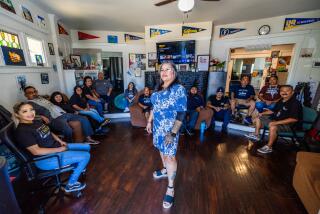LAPD May Manufacture Cocaine for Bait in Stings : Drugs: The agency is considering providing crack--made in its own labs, if needed--to undercover officers for reverse sting operations. Other departments use similar tactics.
- Share via
Taking a cue from Orange County authorities, the officer in charge of street-level narcotics investigations for the Los Angeles Police Department is preparing a proposal to establish reverse sting operations to catch illegal drug users and, if necessary, manufacture rock--or crack--cocaine in police labs for use as bait.
Until now, the LAPD has never seriously considered such operations. But Capt. Bob Hansohn said the proposal he is preparing for consideration by Chief Willie L. Williams could put some officers on the street dealing drugs undercover much like police in Santa Ana.
There, 350 people have been arrested during the past 18 months by undercover police officers dealing county-made crack cocaine.
If needed, Hansohn said LAPD officers could be supplied with rock cocaine manufactured by the Los Angeles crime lab.
Authorities have said most of those arrested in Orange County were first-time buyers and were assigned to drug diversion programs instead of receiving jail or prison terms.
“If the conventional methods aren’t working, I believe we have the obligation to look at knocking out the problem in other ways,” Hansohn said. “This proposal is just in the preliminary stages. (Chief Williams) may or may not agree.”
Pasadena police have been selling street drugs, rather than those cooked by police, during reverse stings for about eight years, Lt. Jerry Schultze said.
In the court order approving Santa Ana’s program, the Orange County district attorney’s office cited two Pasadena cases in which state courts ruled that reverse stings were legal.
The Inglewood Police Department has been selling rock cocaine undercover since 1988, when it combined its program with a billboard campaign that warned: “Behind That Rock Could Be a Cop,” Capt. Jim Seymour said.
In Santa Ana, authorities said their stings are intended to make small-time buyers eligible for harsher punishments. Deputy Dist. Atty. Carl Armbrust said Friday that the reverse stings help officers build felony rap sheets against users who will eventually be eligible for prison sentences if they are arrested a second time.
Orange County Public Defender Ronald Y. Butler questioned whether the police actions amount to entrapment.
“Since most of these people are first-time offenders, you have to wonder if they would be purchasing drugs at all if the police weren’t out there enticing them,” Butler said. “I would seriously question the efficacy of their efforts. I think the motives are pure, but the means to the end seem to be really stretching it.”
Armbrust and Santa Ana police officials defend the operations in which the Orange County Crime Laboratory has been manufacturing $10 and $20 pieces of rock cocaine for undercover officers to sell on the street.
“You can’t measure the success of this program just by how many people end up in jail,” said Santa Ana Police Lt. Robert Helton. “We also rely on people in the neighborhoods to tell us whether things are getting better. I think we are seeing a significant degree of success here.”
Butler said his staff will file a legal brief as early as Monday, contending that the manufacture of the highly addictive crack cocaine amounts to “outrageous government conduct.”
The public defender’s brief is patterned after a similar legal objection filed in Broward County, Fla., where a state appeals court ruled that the county sheriff acted illegally in manufacturing rock cocaine for undercover drug investigations.
The Florida ruling resulted in the reversal of hundreds of convictions obtained from reverse sting investigations.
More to Read
Sign up for Essential California
The most important California stories and recommendations in your inbox every morning.
You may occasionally receive promotional content from the Los Angeles Times.











